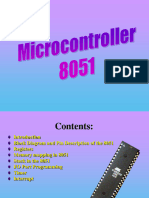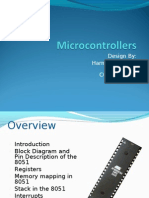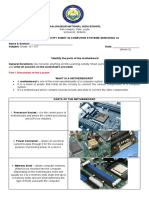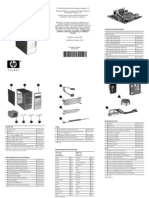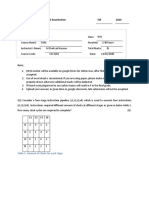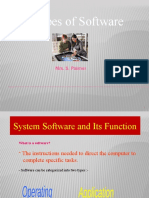Presentation on
8051 MICROCONTROLLER
Submitted By:
Neetu thind ( 2308241)
Submitted to:
Electronics Department Ambala college of engineering and applied research
�Contents:
Introduction Block Diagram and Pin Description of the 8051 Registers Memory mapping in 8051 Stack in the 8051 I/O Port Programming Timer Interrupt
�Embedded System
Embedded system means the processor is embedded into that application. An embedded product uses a microprocessor or microcontroller to do one task only. In an embedded system, there is only one application software that is typically burned into ROM. Exampleprinter, keyboard, video game player
�Why do we need to learn Microprocessors/controllers?
The microprocessor is the core of computer systems. Nowadays many communication, digital entertainment, portable devices, are controlled by them. A designer should know what types of components he needs, ways to reduce production costs and product reliable.
�Different aspects of a microprocessor/controller
Hardware :Interface to the real world
Software :order how to deal with inputs
�Microprocessor vs. Microcontroller
Microprocessor CPU is stand-alone, RAM, ROM, I/O, timer are separate designer can decide on the amount of ROM, RAM and I/O ports. expansive versatility general-purpose Microcontroller CPU, RAM, ROM, I/O and timer are all on a single chip fix amount of on-chip ROM, RAM, I/O ports for applications in which cost, power and space are critical single-purpose
�The necessary tools for a microprocessor/controller
CPU: Central Processing Unit I/O: Input /Output Bus: Address bus & Data bus Memory: RAM & ROM Timer Interrupt Serial Port Parallel Port
�Microcontroller :
A smaller computer On-chip RAM, ROM, I/O ports... ExampleMotorolas 6811, Intels 8051, Zilogs Z8 and PIC 16X
CPU
RAM ROM
A single chip
I/O Port
Serial Timer COM Port Microcontroller
�Three criteria in Choosing a Microcontroller
1. meeting the computing needs of the task efficiently and cost effectively speed, the amount of ROM and RAM, the number of I/O ports and timers, size, packaging, power consumption easy to upgrade cost per unit 2. availability of software development tools assemblers, debuggers, C compilers, simulator 3. wide availability and reliable sources of the microcontrollers.
�Block Diagram
External interrupts Interrupt Control On-chip ROM for program code
Timer/Counter
On-chip RAM
Timer 1 Timer 0
Counter Inputs
CPU
Serial Port
OSC
Bus Control
4 I/O Ports
P0 P1 P2 P3
TxD RxD
Address/Data
�PIN DISCRIPTIONthe 8051 Pin Description of OF PIC
�Pins of PIC 16 F72
Vccpin 20 Vcc provides supply voltage to the chip. The voltage source is +5V. GNDpin 19ground Crystal Oscillator 4MHZ (pin 9& 10) : -Provides stability to the PIC IC
�Figure (a). XTAL Connection to 8051
Using a quartz crystal oscillator We can observe the frequency on the XTAL2 pin. C2 XTAL2 30pF C1 XTAL1 30pF GND
�Pins of 80512/4
RSTpin 9reset It is an input pin and is active highnormally low. The high pulse must be high at least 2 machine cycles. It is a power-on reset. Upon applying a high pulse to RST, the microcontroller will reset and all values in registers will be lost. Reset values of some 8051 registers
�Figure (b). Power-On RESET Circuit
Vcc
+ 10 uF 30 pF 8.2 K 30 pF 18 X2 9 RST 31 EA/VPP X1
19
11.0592 MHz
�Pins of 80513/4
/EApin 31external access
There is no on-chip ROM in 8031 and 8032 . The /EA pin is connected to GND to indicate the code is stored externally. /PSEN ALE are used for external ROM. For 8051, /EA pin is connected to Vcc. / means active low. /PSENpin 29program store enable This is an output pin and is connected to the OE pin of the ROM.
�Pins of 80514/4
ALEpin 30address latch enable It is an output pin and is active high. 8051 port 0 provides both address and data. The ALE pin is used for de-multiplexing the address and data by connecting to the G pin of the 74LS373 latch. I/O port pins The four ports P0, P1, P2, and P3. Each port uses 8 pins. All I/O pins are bi-directional.
�Pins of I/O Port
The 8051 has four I/O ports Port 0 pins 32-39P0P0.0P0.7 Port 1pins 1-8 P1P1.0P1.7 Port 2pins 21-28P2P2.0P2.7 Port 3pins 10-17P3P3.0P3.7 Each port has 8 pins. Named P0.X X=0,1,...,7, P1.X, P2.X, P3.X ExP0.0 is the bit 0LSBof P0 ExP0.7 is the bit 7MSBof P0 These 8 bits form a byte. Each port can be used as input or output (bi-direction).
�Other Pins
P1, P2, and P3 have internal pull-up resisters. P1, P2, and P3 are not open drain. P0 has no internal pull-up resistors and does not connects to Vcc inside the 8051. P0 is open drain. Compare the figures of P1.X and P0.X. However, for a programmer, it is the same to program P0, P1, P2 and P3. All the ports upon RESET are configured as output.
�Port 3 Alternate Functions
P3 Bit
P3.0 P3.1 P3.2 P3.3 P3.4 P3.5 P3.6 P3.7
Function
RxD TxD INT0 INT1 T0 T1 WR RD
Pin
10 11 12 13 14 15 16 17
�Registers
A B R0 R1 R2 R3 R4 R5 R6 Some 8051 16-bit Register PC PC DPTR DPH DPL
R7 Some 8-bitt Registers of the 8051
� RAM memory space allocation in the 8051
7FH Scratch pad RAM
30H
2FH
Bit-Addressable RAM 20H 1FH 18H 17H 10H 0FH 08H 07H 00H Register Bank 2 (Stack) Register Bank 1 Register Bank 3
Register Bank 0
�Stack in the 8051
The register used to access the stack is called SP (stack pointer) register. The stack pointer in the 8051 is only 8 bits wide, which means that it can take value 00 to FFH. When 8051 powered up, the SP register contains value 07.
7FH Scratch pad RAM 30H 2FH
Bit-Addressable RAM
20H 1FH 18H 17H 10H 0FH 08H 07H 00H
Register Bank 3 Register Bank 2 (Stack) Register Bank 1 Register Bank 0
�TMOD Register:
Gate : When set, timer
high.
only runs while INT(0,1) is
C/T : Counter/Timer select bit. M1 : Mode bit 1. M0 : Mode bit 0.
�TCON Register:
TF1: Timer 1 overflow flag. TR1: Timer 1 run control bit. TF0: Timer 0 overflag. TR0: Timer 0 run control bit. IE1: External interrupt 1 edge flag. IT1: External interrupt 1 type flag. IE0: External interrupt 0 edge flag. IT0: External interrupt 0 type flag.
�Interrupt Enable Register :
EA : Global enable/disable.
--: Undefined.
ET2 :Enable Timer 2 interrupt. ES :Enable Serial port interrupt. ET1 :Enable Timer 1 interrupt. EX1 :Enable External 1 interrupt. ET0 : Enable Timer 0 interrupt. EX0 : Enable External 0 interrupt.
�Thank you

